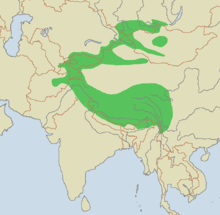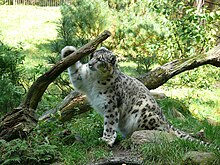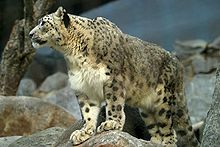Snow leopard: Difference between revisions
No edit summary |
Revert to revision 244852642 dated 2008-10-12 21:41:22 by 92.3.59.58 using popups |
||
| Line 22: | Line 22: | ||
The '''snow leopard''' (''Uncia uncia''), sometimes known as the '''ounce''', is a large cat native to the mountain ranges of [[Central Asia]] from Afghanistan, Northern [[India]] ([[Himalayas]]), northern [[Pakistan]], to Lake [[Baikal]] and eastern [[Tibet]]. The taxonomic position of this species has been subject to change. In the past, many taxonomists included the snow leopard in the genus ''[[Panthera]]'', with several of the other largest [[felidae|felids]], but later it was placed in its own genus, '''''Uncia'''''. However, a recent molecular study places the species firmly within the genus ''Panthera'', although the exact position remains unclear.<ref name=Johnson2006>Johnson, W.E., Eizirik, E., Pecon-Slattery, J., Murphy, W.J., Antunes, A., Teeling, E. & O'Brien, S.J. 2006. [http://www.sciencemag.org/cgi/content/abstract/311/5757/73 The Late Miocene radiation of modern Felidae: A genetic assessment.] [[Science (journal)|Science]] 311: 73-77; access date = September 26, 2006</ref> It cannot roar, despite possessing an incomplete ossification of the [[hyoid bone]], which was thought to be essential in allowing the big cats to roar. However, new studies show that the ability to roar is due to other [[Morphology (biology)|morphological]] features, especially of the [[larynx]], which are absent in the snow leopard.<ref name="Walker">{{cite book | last = Nowak | first = Ronald M. | title = Walker's Mammals of the World | publisher = [[Johns Hopkins University Press]] | date = 1999 | id = ISBN 0-8018-5789-9}}</ref> Well known for its beautiful fur, the snow leopard has a whitish-tan coat with ringed spots of dark, ashy-brown and rosettes of black. Its tail is heavy with fur and the bottom of its paws are covered with fur for protection against snow and cold. |
The '''snow leopard''' (''Uncia uncia''), sometimes known as the '''ounce''', is a large cat native to the mountain ranges of [[Central Asia]] from Afghanistan, Northern [[India]] ([[Himalayas]]), northern [[Pakistan]], to Lake [[Baikal]] and eastern [[Tibet]]. The taxonomic position of this species has been subject to change. In the past, many taxonomists included the snow leopard in the genus ''[[Panthera]]'', with several of the other largest [[felidae|felids]], but later it was placed in its own genus, '''''Uncia'''''. However, a recent molecular study places the species firmly within the genus ''Panthera'', although the exact position remains unclear.<ref name=Johnson2006>Johnson, W.E., Eizirik, E., Pecon-Slattery, J., Murphy, W.J., Antunes, A., Teeling, E. & O'Brien, S.J. 2006. [http://www.sciencemag.org/cgi/content/abstract/311/5757/73 The Late Miocene radiation of modern Felidae: A genetic assessment.] [[Science (journal)|Science]] 311: 73-77; access date = September 26, 2006</ref> It cannot roar, despite possessing an incomplete ossification of the [[hyoid bone]], which was thought to be essential in allowing the big cats to roar. However, new studies show that the ability to roar is due to other [[Morphology (biology)|morphological]] features, especially of the [[larynx]], which are absent in the snow leopard.<ref name="Walker">{{cite book | last = Nowak | first = Ronald M. | title = Walker's Mammals of the World | publisher = [[Johns Hopkins University Press]] | date = 1999 | id = ISBN 0-8018-5789-9}}</ref> Well known for its beautiful fur, the snow leopard has a whitish-tan coat with ringed spots of dark, ashy-brown and rosettes of black. Its tail is heavy with fur and the bottom of its paws are covered with fur for protection against snow and cold. |
||
The life span of a snow leopard is normally 15–18 years, but in captivity it can live up to |
The life span of a snow leopard is normally 15–18 years, but in captivity it can live up to 20 years. |
||
Revision as of 04:50, 13 October 2008
| Snow Leopard[1] | |
|---|---|

| |
| Scientific classification | |
| Kingdom: | |
| Phylum: | |
| Class: | |
| Order: | |
| Family: | |
| Subfamily: | |
| Genus: | Uncia
|
| Species: | U. uncia
|
| Binomial name | |
| Uncia uncia (Schreber, 1775)
| |

| |
| Range map | |
The snow leopard (Uncia uncia), sometimes known as the ounce, is a large cat native to the mountain ranges of Central Asia from Afghanistan, Northern India (Himalayas), northern Pakistan, to Lake Baikal and eastern Tibet. The taxonomic position of this species has been subject to change. In the past, many taxonomists included the snow leopard in the genus Panthera, with several of the other largest felids, but later it was placed in its own genus, Uncia. However, a recent molecular study places the species firmly within the genus Panthera, although the exact position remains unclear.[3] It cannot roar, despite possessing an incomplete ossification of the hyoid bone, which was thought to be essential in allowing the big cats to roar. However, new studies show that the ability to roar is due to other morphological features, especially of the larynx, which are absent in the snow leopard.[4] Well known for its beautiful fur, the snow leopard has a whitish-tan coat with ringed spots of dark, ashy-brown and rosettes of black. Its tail is heavy with fur and the bottom of its paws are covered with fur for protection against snow and cold.
The life span of a snow leopard is normally 15–18 years, but in captivity it can live up to 20 years.
Ecology
In summer, the snow leopard usually lives above the tree line on mountainous meadows and in rocky regions at an altitude of 2,700 m (8,900 ft) to 6,000 m (20,000 ft). In winter, it comes down into the forests at an altitude of about 2,000 m (6,600 ft). It leads largely a solitary life, although mothers can rear cubs for extended periods of time in cave dens in the mountains. It is an opportunistic feeder, eating whatever meat it can find and kills animals three times its size, including domestic livestock. Its diet consists mainly of ibexes, the Bharal, the Markhor, the Urial, deer, boars, as well as pikas, marmots and other small rodents. It ambushes prey from above when possible, as it can jump as far as 14 meters (46 ft).[5] Its agility often proves helpful when ambushing prey and traversing through mountains.
An individual snow leopard lives within a well defined home range. However, it does not defend its range aggressively when encroached upon by other individuals. Home ranges can vary greatly in size. In Nepal, where prey is abundant, a home range can be as small as 12 km2 (5 sq mi) to 39 km2 (15 sq mi) and up to 5 to 10 animals are found here per 100 km2 (39 sq mi); whereas, in habitats with sparse prey, an area of 1,000 km2 (386 sq mi) supports only 5 of these cats.[4]
Range
The snow leopard's range in central and south Asia is rugged mountainous regions of approximately 1,230,000 square kilometers, which extends through 12 countries: Afghanistan, Bhutan, China, India, Kazakhstan, the Kyrgyz Republic, Mongolia, Nepal, Pakistan, Russia, Tajikistan, and Uzbekistan.
The geographic distribution streches from the Hindukush in eastern Afghanistan and the Syr Darya through the mountains of Pamir Tien Shan, Karakorum, Kashmir, Kunlun, and the Himalaya to southern Siberia, where the range covers the russian Altai, Sajan, Tannu-Ola Mountains and the mountains to the west of Lake Baikal. In Mongolia it is found in the Mongolian and Gobi Altai and the Khangai Mountains. In Tibet it is found up to the Altyn-Tagh in the North.[6]
Population and conservation


The total wild population of the snow leopard is estimated at between 4,000 and 7,500 individuals (see table below). In 1972 the International Union for the Conservation of Nature, (IUCN) placed the snow leopard on its Red List of Threatened Species as "Endangered," the same classification given the panda and the tiger.
There are also 600-700 snow leopards in zoos around the world.[7]
| Range Country | Habitat Area (sq. km.) |
Estimated Population[7] |
|---|---|---|
| Afghanistan | 50,000 | 100-200 |
| Bhutan | 15,000 | 100-200 |
| China | 1,100,000 | 2,000-5,000 |
| India | 75,000 | 200-600 |
| Kazakhstan | 50,000 | 180-200 |
| Kyrgyz Republic | 105,000 | 150-500 |
| Mongolia | 101,000 | 500-1000 |
| Nepal | 30,000 | 300-500 |
| Pakistan | 80,000 | 200-420 |
| Tajikistan | 100,000 | 180-220 |
| Uzbekistan | 10,000 | 20-50 |

Protected Areas:
- Chitral Gol National Park, in the NWFP, Pakistan.
- Hemis National Park, in east Ladakh, India.
- Khunjerab National Park, Northern Areas, Pakistan.
- Nanda Devi National Park, in state of Uttarakhand, India, a UNESCO Natural World Heritage Site.[8]
- Qomolangma National Nature Preserve, Tibet, China.[9]
- Sagarmatha National Park, Nepal, a UNESCO Natural World Heritage Site.[10]
- Tumor Feng Nature Reserve, western Tianshan Mountains, Xinjiang, China.[11]
- Valley of Flowers National Park, Uttaranchal, India, a UNESCO Natural World Heritage Site.
- Shey-Phoksundo National Park, Dolpa, Nepal.
- Dhorpatan Hunting Reserve,Baglung, Nepal.
- Annapurna Conservation Area, Western Nepal.
- Jigme Dorji National Park, Bhutan
- Gobi Gurvansaikhan National Park, Mongolia
- Ubsunur Hollow, on the territorial border of Mongolia and the Republic of Tuva
Much progress has been made in securing the survival of the snow leopard, with snow leopards being successfully bred in captivity. The animals usually give birth to 2 to 3 cubs in a litter, but can give birth to up to 7 in some cases.
Conservation efforts
There are numerous agencies working to conserve the snow leopard and its threatened mountain ecosystems. These include the Snow Leopard Trust, the Snow Leopard Conservancy and the Snow Leopard Network. These groups and numerous snow leopard range country governments, non-profits and donors from around the world recently worked together at the 10th International Snow Leopard Conference in Beijing. Their focus on research, community programs in snow leopard regions and education programs are aimed at understanding the cat's needs as well as the needs of the villagers and herder communities impacting snow leopards' lives and habitat.[12]
Snow leopard in heraldry
The snow leopard (almost invariably known in heraldry as the ounce) (Aq Bars) is a national symbol for Tatars and Kazakhs: a snow leopard is found on the official seal of the city of Almaty, and a winged snow leopard is found on Tatarstan's coat of arms. A similar leopard is featured at the coat of arms of North Ossetia-Alania. The snow leopard award was given to Soviet mountaineers who scaled all five of the Soviet Union's 7000m peaks. In addition, the snow leopard is the symbol of the Girl Scout Association of Kyrgyzstan.
-
Snow leopard on the backside of the old 10000 tenge (Kazakhstan) banknote.
-
Snow leopard as a symbol of Almaty, Kazakhstan.
-
Snow leopard as a symbol of Astana, the capital of Kazakhstan.
-
Snow leopard as a symbol of Bishkek, the capital of Kyrgyzstan.
References
- ^ Wozencraft, W. C. (2005). "Order Carnivora". In Wilson, D. E.; Reeder, D. M. (eds.). Mammal Species of the World: A Taxonomic and Geographic Reference (3rd ed.). Johns Hopkins University Press. p. 548. ISBN 978-0-8018-8221-0. OCLC 62265494.
- ^ Template:IUCN2008
- ^ Johnson, W.E., Eizirik, E., Pecon-Slattery, J., Murphy, W.J., Antunes, A., Teeling, E. & O'Brien, S.J. 2006. The Late Miocene radiation of modern Felidae: A genetic assessment. Science 311: 73-77; access date = September 26, 2006
- ^ a b Nowak, Ronald M. (1999). Walker's Mammals of the World. Johns Hopkins University Press. ISBN 0-8018-5789-9.
- ^ "Animal Bytes: snow leopard". San Diego Zoo. 2007. Retrieved 2007-05-05.
- ^ Mammals of the Soviet Union. Vol III: Carnivores (Feloidea).
- ^ a b "Population and Protections". Snow Leopard Trust. 2008. Retrieved 2008-07-03.
- ^ UNESCO World Heritage Centre Nanda Devi and Valley of Flowers National Parks. Brief Description. Retrieved 27 November 2006.
- ^ Snow Leopard Conservancy. 2006. Training park managers in the conservation of snow leopards. Retrieved 27 November 2006.
- ^ UNESCO World Heritage Center. Sagarmatha National Park: Brief Description. Retrieved 27 November 2006.
- ^ Snow Leopard Network. 2005. Camera Trapping of Snow Leopards in the Muzat Valley. Retrieved 27 November 2006.
- ^ Theile, Stephanie “Fading footprints; the killing and trade of snow leopards” TRAFFIC International, 2003






